Next: Portland
Trip to Maine 2009
Maine central coast, 19–20 Aug 2009
Maine's central coast between Acadia National Park and Portland is popular with tourists for its pretty towns, plentiful fresh seafood and ocean views.

We passed over the Penobscot Narrows Bridge on the way north but this time, headed south, we were going to stop and look.
Not a bad picture from a mobile phone considering it was through the windscreen/windshield and I was driving at the time. There was no one around so I could slow down.
Incidentally, I assume the name of the town is pronounced Bucks-port, rather than Buck-sport since it is on a major waterway where ships used to dock i.e. a "port", to take granite away from nearby quarries.
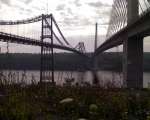
Work to overhaul the Waldo-Hancock Bridge to bring it up to modern standards was partially complete in 2000 when further inspection revealed the structure had deteriorated so much on the other side that the focus shifted to temporary strengthening while a new bridge was built.
The guide told us that trucks were immediately forbidden from using it forcing them to detour through Bangor, 25 miles (40km) upstream. Now not even pedestrians are allowed on the old bridge and it will be demolished when funds are available.

Possibly it was faulty for some reason so they kept it for educational purposes and I'm glad they did. The bridge seems narrow when you drive over but it's big when you walk up to this piece.

It's quite an attractive flower so long as you don't touch it.
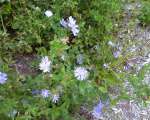

… or by the scientific name Rudbeckia hirta.
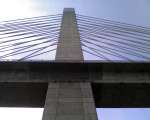
We are going up there!

Note that there is no separate pedestrian/bicycle lane on either bridge. I find that incredible, particularly on the new one.
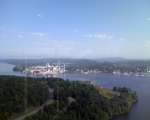
That large industrial facility is a paper mill.

That is the town of Bucksport on the far side.
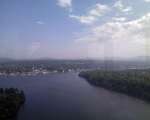
The land on the right is actually an island.

The ocean is in the distance.
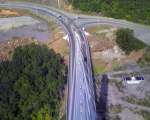
You can see the educational bridge section on the right. It looks small from up here.

Can you see the moose? It's in the middle between the farmer and the sailor. Read all about it.

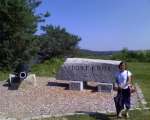
No, not that For Knox. This is this Fort Knox.. It's right next to the bridge.
Note that Lan has her parasol at the ready. It is still too hot to be comfortable!

The barracks for the soldiers was supposed to be built on the left side but the civil war happened before the fort was complete. In any case, there was no action this far north so it wasn't needed.

There is a huge gun behind Lan but it was quite dark and my photo came out blurry. More on the gun in a second.
A close look at this picture tells you quite a lot about the gun that fired it. You'll see there is a hole visible in one so it appears to be an shell i.e. one that is hollow inside to contain explosives, as opposed to a solid iron ball. When the fort was constructed in the mid-19th Century, cannon were making the transition from smooth bore barrels which shot round cannon balls to those with rifling – grooves or ridges in the barrel to make the projectile spin giving far greater accuracy – which fired "pointy", indeed bullet-shaped, projectiles.
As it turns out, the big gun is a 10" (250mm) Rodman cannon which pioneered a new casting technique, cooling from the inside out, rather than outside in, which made it much stronger.
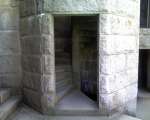
The tour guide said there were only a handful of spiral staircases in American forts and this one had two. We felt sorry for the young woman who was somewhat overweight and she seemed to struggle in the heat.

The rooms receding into the distance were (I think) intended for lower-ranking officers and there are a few steps up from one to the next, allowing heat from the kitchen fires to warm all the rooms—an important thing in a Maine winter.
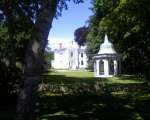
Belfast was once home to a large shipbuilding industry. There hasn't much call for wooden ships for a long time so the industry died but the stately homes remain.

The town is proud of its heritage and has marked some of the more important buildings as part of the Museum in the Streets program. This is one place I definitely want to go back to and it would be fun to live here for a year or two, even through the winter.

Strangely there was no Museum in the Streets sign outside this one.
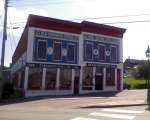
Actually the tourist office is only in the right half but the man inside was very helpful and gave us the map showing the historic buildings. However it was (still) too hot to walk about so we drove to some of them.
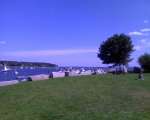
My paper map mentions the "Regal Passenger Steamer" for this location, once the site of a shipyard but the Belfast Area Chamber of Commerce website reminds me that "The SS Belfast, the 'Great White Flyer' of the Eastern Steam Ship Co. of Boston, plied the waters on Penobscot Bay, carrying passengers, freight and mail for thirty-six years.".
The Jennie Flood Kreger was built in the adjacent shipyard and "was the largest and only five-masted ship to be built in Belfast. Launch day, March 5, 1919, drew a large and excited crowd". If it was the "only" five-masted ship built here, it was presumably also the smallest of that type.

On close inspection of the map, I'm not sure if this is the Opera House which might be immediately to the right of this photo. Nevertheless, it is a pretty building.

A fire in 1865 and another in 1873 destroyed most of the town's commercial hub but it was rebuilt in brick so it lasted.


We walked down the main street and back but there wasn't much to see and the heat made it unpleasant.

While Camden, just 3 miles away, was crawling with tourists, Rockport was quiet and unpretentious. Much more my sort of town.
The Fodor's travel guide quotes Yankee magazine saying that the coast road between Camden and Rockport is, "The prettiest walk in the world". I was expecting spectacular coastal views like the Great Ocean Road but all we saw were large houses hidden behind lots of trees.
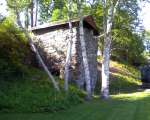
Before Portland cement became readily available in the latter half of the 19th Century, lime mortar was used on brick and stone construction. Finding another use for Maine's then abundant forests, timber-fueled kilns such as this one heated crushed limestone from nearby quarries (calcium carbonate CaCa3) to 1800°F/1000°C to make quicklime (calcium oxide, CaO) which was subsequently combined with water to make slaked lime or hydrated lime (calcium hydroxide, Ca(OH)2) to be shipped from the adjacent docks.
Hence the name for the town—the port for rock became Rockport.

To protect the town's link with its industrial past, this one has a hat to protect it from the elements.

A local family "adopted" an orphaned seal in the 1970s, called it Andre and later wrote a book about the experience which became a film
Note that it is Andre, not Alex, which some have thought to be the subject of a hit song by the Go-Gos.
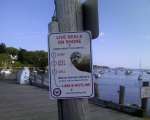

The museum is on the southern side of Bath, a town that has built 5,000 ships. In the mid-1800s it was the 5th-busiest port in the country.
See the museum's web site.

From a peak of 200 shipyards operating in Bath, there is now just one, the Bath Iron Works which alone was able to make the transition from wood to steel and sail to steam, though now it is owned by General Dynamics, a defense contractor.
I was surprised to learn that modern shipyards no longer launch ships by letting them slide down a slipway in to the water. Instead, the ship is moved on rails onto a floating dry dock and gently lowered into the water, a much more controlled action. Underscoring how the Bath Iron Works now only builds ships for the military, this dry dock was built in China.

If you are a US taxpayer, you have contributed to the DDG-109 Jason Dunham, an Arleigh Burke class destroyer which was launched on 1-Aug-09 just a few weeks before our arrival.

The young man giving the guided tour on the boat noted that an osprey's nest had been discovered during bridge maintenance work, that work had to stop and an artificial nest was constructed nearby, all at a cost of $80,000 which he thought could have been better used to buy him a Dodge Viper.
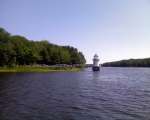
This lighthouse on the Kennebec River marks a bend in the river and since it will be sighted from from only a mile or so and the waves are small, it can be low to the water. Strong tidal flows can produce turbulent currents immediately off the headland and we were told a story of a sailor so happy to be returning to his home town after a long voyage that he grabbed his fiddle, perched himself on the bowsprit and played with passion. Upon entering the whirlpool, the ship lurched, the sailor fell in the water and drowned within sight of home … and to this day on a still night you can still here the muffled sounds of the fiddle coming from the deep.

The lighthouse keeper had to raise the weights that drove the clockwork mechanism every 4 hours when it was foggy. I think the guide said they weighed 1200 lbs (550kg). What a drag.
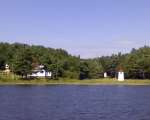
When the two lights are in line, the ship's navigator knew he was in the channel. Upon seeing the other lighthouse, the ship would be turned to port (left).

The museum incorporates the grounds of the former Percy & Small Shipyard which built the 6-masted schooner Wyoming (photo), the longest wooden ship ever built. A sculpture shows the outlines of bow (front) and stern (back) of the ship and it is hoped to one day fill in the bit in the middle.
.
This is a boat that once worked the rich fishing grounds of the Grand Banks and despite appearances, was powered by a steam engine with the sails fitted only to stabilize the vessel in heavy seas. She is a sister ship to the famous racer Blue Nose. More …

The Sherman Zwicker carried a dozen stackable dories like this from which two men cast off a line 1½ miles (2.4km) long with hooks fastened every 9 ft (2.7m) on 3 ft (1m) lines, returning to the mother ship to offload their catch using pitchforks. At the end of the day, the men and their boats were hoisted aboard and then the thousands of fish were gutted and salted.
Larger and larger refrigerated ships that towed massive nets made the Zwicker obsolete and became so efficient at harvesting the fish, mainly cod, that by the 1990s there were virtually none left. I highly recommend you read Cod: A Biography of the Fish that Changed the World and see how decades of warnings from scientists were unable to move fisherman and politicians to take meaningful action until it was too late.
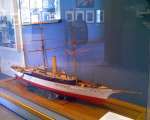
The Bath Iron Works built the Eleanor for William A. Slater in 1894 and at the time it was the largest and most luxurious American-built yacht of its day. In the following two years it sailed around the world with a crew of 32.
In about 1900 it was sold to Charles F. Baker, Jr and renamed the Wacouta. With America's entry into the World War 1 in 1917, the ship was donated to the US Navy to be converted to a patrol boat and renamed the Harvard and used as a convoy escort. On July 15th of that year, it rescued 30 survivors from the Exford and another 59 the following day from the Trelissick. In 1919 it was returned to its former owners and then sold to Greek owners for passenger service between Greece and italy. It was still in operation into the 1950s but final fate is unclear.
- Launched: 1894
- Length: 232 ft (71m)
- Bredth: 32 ft (10m)
- Draft: 13ft (4m)
- Displacement: 1136 tons
- Engine: 1 triple expansion steam engine of 1000hp (745kW)
- Sail area: 13,215 ft2 (1225m2)
- Cost: $300,000

Another product of the Bath Iron Works, this beautiful mega-yacht was built for J.P. Morgan, Jr, son of the tycoon J. Pierpont Morgan and launched in 1930. Read the full story.

One thing I had not expected to see in Maine was a photo of Newcaslte but there it is with at least a dozen sailing ships tied up at the wharf in 1890, presumably loading coal.

A big buoy to mark the channel for big ships.
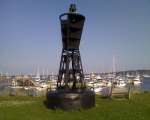
Large Navigational Buoy (LNB) such as this have a bell with hammers that bang against it as the buoy moves with the waves and to my surprise, also hold acetylene tanks to power an automated light. Buoys like this were very cheap compared to a lightship and so could be installed in many more hazardous locations, becoming so effective that most lightships were replaced.
I just discovered that the 1912 Nobel Prize for Physics was awarded to Gustaf Dalén, "in recognition of his remarkable invention of automatic valves designed to be used in combination with gas accumulators in lighthouses and light-buoys". Acetylene powered buoys were in use in America until the mid-1960s until replaced by electrically-powered models.
This particular one broke free of its mooring and drifted across the Atlantic to wash ashore in Ireland!

The breakwater at Rockland. Being in the wind near the water made a nice cool end to a hot day.
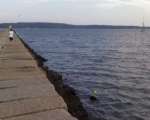
If you look carefully, you'll see a small sailing ship at the top-right. I include this photo to remind myself of the boy who has probably seen Pirates of the Caribbean too many times because upon sighting it he asked his parents, "Is that a pirate ship?!!!". His parents didn't think so which led him to ask if he could go see it. His parents pointed out they didn't have a boat to get out there. Undeterred, he asked, "Can we swim out?".
Probably wisely, his parents turned down that request too.

While it would have been nice to stroll out to the lighthouse, the huge granite blocks were irregularly-shaped with large gaps as large as 8" (20cm) so there were plenty of opportunities to break your leg and therefore ruin the afternoon so it was necessary to look down all the way.
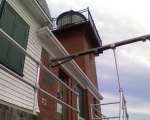
There is also a fog horn that sounds every 30 seconds or so—even when there is no fog.

No wonder we were tired. The breakwater is 4200ft (1280m) or 4/5th of a mile! I was surprised that such a massive wall against the sea was built in the 1800s.
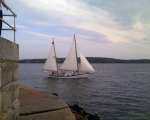
The AAA tour guide says Rockland is the "Schooner Capital of the World" though we only saw one. Since the mast at the front is taller, I think this is a ketch.

At the Maine Lighthouse Museum with a 3rd-order Fresnel lens which takes the light beams from the lamp inside and makes them horizontal so it can be seen from much further away.

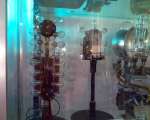
When navigation buoys were fitted with electric lights, a bulb failure could lead to catastrophe so mechanisms were used to automatically swap in a new one.
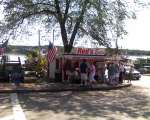
Wiscasset is meant to be a pretty little town but the constant traffic on Route 1 made Maine Street difficult to cross and the heat took away our motivation. We were amused though to see the line forming outside this roadside stall at 11:15am, 15 minutes before it opened. I guess it was good.